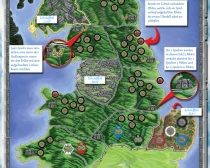Review: Albion
Posted by James (admin) on November 24th, 2009
 When I heard the designer of Carcassonne had a new game, I knew I wanted to check it out. Players build forts and towns in the land of Albion (Roman Britain) where the south is tame but the north is inhabited by the Picts who are less welcoming to the Romans. Each player controls Settlers (who build buildings and collect resources) and Legionnaires (who increase military strength in their region). The first player to complete three level 4 buildings (including one in a far North region where it is most hostile) wins.
When I heard the designer of Carcassonne had a new game, I knew I wanted to check it out. Players build forts and towns in the land of Albion (Roman Britain) where the south is tame but the north is inhabited by the Picts who are less welcoming to the Romans. Each player controls Settlers (who build buildings and collect resources) and Legionnaires (who increase military strength in their region). The first player to complete three level 4 buildings (including one in a far North region where it is most hostile) wins.
MOVEMENT
An interesting gameplay mechanic is movement. Each turn, a player can move as many of their own units as they want. The number of regions (distance) each unit can move is dictated by what buildings the player has built. At the end of the player’s turn, all settler units are returned to a home camp. At the start of the game, players only have one home camp in the South. Legionnaires do not have to return to these bases each turn.
BUILDINGS
Settler units can create level 1 buildings (if the player doesn’t already have a building in that region) or develop an existing building by one level. This costs one unique resource for each level of the new building. There are 4 different resources in Albion (fish, wood, stone and gold) and the player only starts with access to 2 of them – the others are further north. New or developed buildings give the player extra abilities such as gaining a settler unit, gaining a legionnaire unit, +1 movement, +1 military strength, a free building development, a new home base, and a few others. Also, if you develop a building in an area where another player has a higher level building, you must give them one resource.
PICTS
When you create/develop a building, you must turn over a face-down Pict token in that region (if there are any left) and add up the total of the hostile Pict icon, including any that are permanently drawn on the board in some regions. If this number is greater than any player’s own military strength (based on buildings owned and any legionnaires in that region) then that player’s building is destroyed by the Picts. SO, more than one player could be affected. Note that you can not directly attack other players.
 OVERALL
OVERALL
Some of Albion’s gameplay mechanics feel quite different to many other games like the way units move back to home base as if they’re on elastic and the way you assess if Picts destroy buildings. The order in which you build different buildings is absolutely critical to your game. Do you increase your movement range, or get more units first to accomplish more each turn? Do you develop your resource centres so you get more resources each time you gather them, or do you be the first to build in a region so the other player has to pay you a resource? Tight resource management ensures you can not do everything you want and the timing of your actions compared to other players can also be important. These principles all sound good and the game does feel different to other games. Increasing your gathering power, movement range and military might whilst trying to be first to expand is a lot to consider, which is a good thing.
However, in spite of this, I didn’t get on with Albion. Looking back, some of this was my fault as I think I made a mistake in my very first turn by developing one thing and not another – I was trying not to do exactly the same actions as the first-player. As a result, I ended up playing catch-up from then onwards because my opponent developed buildings in most regions before I did, which meant I had to give him quite a few resources during the game which made it harder for me. I know that if players that make bad choices they shouldn’t win, but feeling like I couldn’t recover from one choice I made in the first turn felt frustrating. I am hoping this was just a mistake I made and not the game’s fault.
It’s nice to see an empire building game which is not complex and Albion is quite simple with just a few different building types and only two units. However, this can also be a weakness as the options available to you on a turn can often feel quite limited.
Those issues aside, I’m not convinced Albion works well with 2 players as one player in a stronger position can dominate because there is no pressure on them. I’d like to try Albion again with 3 or, preferably, 4 players as I think that would have a lot more decision-making and variety in it, there would be more pressure on the leader, and that would give it the life my game felt it lacked.
Even though my game didn’t go very well, I believe Albion could be a good game. I would like to play it again to find out.
James.
[Played with 2 players]
Read the thoughts of the other player (my friend Rick) at: http://www.gamesetupmatch.com/news.htm#12

